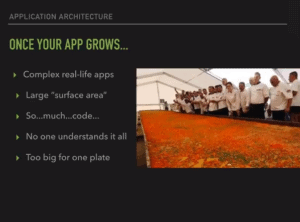Welcome to the fourth ColdFusion Containers Roadshow Webinar by OrtusSolutions. This Friday, Jon Clausen gave a presentation on the topic of “Box Microservices”.
These series are being held throughout the September, every Friday at 11 AM CST. Topics are covering anything you would need to build sustainable containerized ColdFusion applications using CommandBox, ColdBox, and ContentBox CMS technologies.
Contents
- Evolution
- Spaghetti
- Object-oriented code
- Model view controller (MVC)
- If it doesn't perform
- …bigger hardware!
- Monolith vs. Microservices
- The new paradigm is ORCHESTRATION
- What does MICROSERVICES do?
- The road from legacy CFML apps to Microservices architecture
- Toolset
- Isolate- instead of having one thing doing many things
- Starting in Docker
- Links
- Sign up for the webinar
Remember that all webinars are FREE but with limited seats, so hurry up and sign up!
Evolution
- Budgets, options, and other problems
- How you can overcome these problems and evolve?
- Use existing legacy microservices
Spaghetti
- Spaghetti mode start in the 90's
- Quick and dirty
- Monolithic app design
- Noooo separation
- Lots of other difficulties
Object-oriented code
- Logic organized better
- Service-oriented
- Some separation
- Still difficult
Model view controller (MVC)
- Helps enforce OO
- Separates layers of concerns
- Layers still tightly coupled
If it doesn't perform
…bigger hardware!
- Big server = Big database
Monolith vs. Microservices
- Transit from big hardware to…
- Platforms as Services (PAAS)
The new paradigm is ORCHESTRATION
- Less is more
- Apps are collections of independent parts
- Start thinking about not having massive releasing cycles/ decoupling the code
- Hardware independence
- Platform independence
- Disposable instances
- Scale on-demand
- Teardown when demand decreases
- Martin Fowler
What does MICROSERVICES do?
- Make legacy code less intimidating
- Fewer resources required to maintain full tolerance
- Versionable and maintainable
- Short release cycles
- Monolithic apps can be evolved piece by piece
The road from legacy CFML apps to Microservices architecture
- The steps
- Identify performance bottlenecks and pain points in your application
- Build, test and deploy new microservices to address and deliver the functionality of your pain points
- Update the endpoints monolithic app to use new microservice endpoints
- Rinse and repeat, with additional bottlenecks and pain points
Toolset
Containerization
Isolate- instead of having one thing doing many things
… we develop many things, each one doing one thing, very well.
Starting in Docker
- Are you a robot?
- Test out the environment
- Docker Swarm
Links
-
Docker
-
Google app engine
-
Azure
-
Kubernetes
-
Heroku
-
Amazon Web Services (AWS)
-
Ortus Solutions
-
portainer.io
-
Jon Clausen
-
OrtusSolutions Docker ColdFusion Roadshow 2017
-
Ortus books
The whole month of great stuff coming up. Once again, big ups to the guys from OrtusSolutions for putting together this Roadshow.
The next Docker Roadshow is on Sep 29, 2017, 11:00 AM. Gavin Pickin will be talking about “Start playing with Docker”.
Sign up for the webinar
I must say that Ortus always has a very good overview of what’s going on. Very simple, clean, neat Sign up page will welcome you and give you the basic info.
You can choose to attend one or more of the following sessions.
Here is the last date!
Time shows in Central Standard Time (US and Canada)
See you there folks!
And to continue learning how to make your ColdFusion apps more modern and alive, I encourage you to download our free ColdFusion Alive Best Practices Checklist.
Because… perhaps you are responsible for a mission-critical or revenue-generating CF application that you don’t trust 100%, where implementing new features is a painful ad-hoc process with slow turnaround even for simple requests.
What if you have no contingency plan for a sudden developer departure or a server outage? Perhaps every time a new freelancer works on your site, something breaks. Or your application availability, security, and reliability are poor.
And if you are depending on ColdFusion for your job, then you can’t afford to let your CF development methods die on the vine.
You’re making a high-stakes bet that everything is going to be OK using the same old app creation ways in that one language — forever.
All it would take is for your fellow CF developer to quit or for your CIO to decide to leave the (falsely) perceived sinking ship of CFML and you could lose everything—your project, your hard-won CF skills, and possibly even your job.
Luckily, there are a number of simple, logical steps you can take now to protect yourself from these obvious risks.
No Brainer ColdFusion Best Practices to Ensure You Thrive No Matter What Happens Next
ColdFusion Alive Best Practices Checklist
Modern ColdFusion development best practices that reduce stress, inefficiency, project lifecycle costs while simultaneously increasing project velocity and innovation.
√ Easily create a consistent server architecture across development, testing, and production
√ A modern test environment to prevent bugs from spreading
√ Automated continuous integration tools that work well with CF
√ A portable development environment baked into your codebase… for free!
Learn about these and many more strategies in our free ColdFusion Alive Best Practices Checklist.








